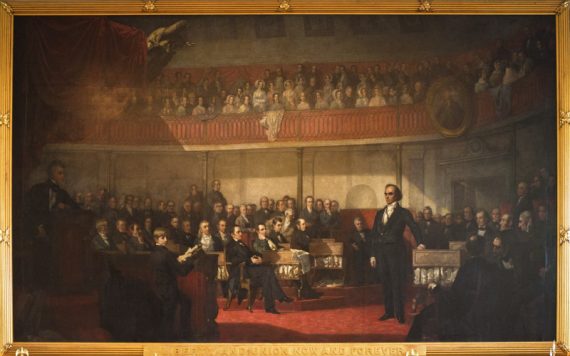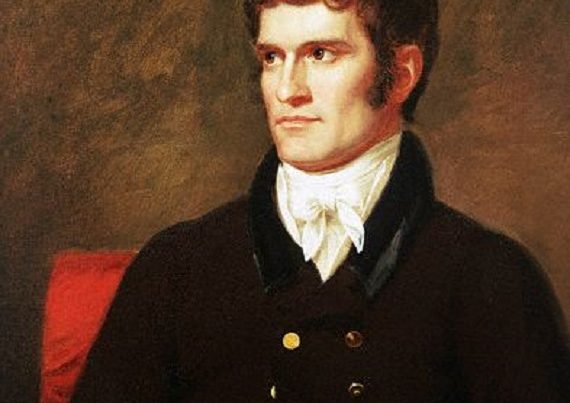The 1850s is viewed by most scholars as the crucial decade of the sectional crisis that resulted in the War Between the States. The Great Triumvirate of John C. Calhoun, Henry Clay, and Daniel Webster had passed from the scene. These giants were replaced by lesser lights, and “the war came” as Mr. Lincoln claimed. As historical explanations go, there are worse. One may already discern the protests of the “righteous cause” crowd crying out against my neglect of the slavery issue, which we are told ad infinitum, ad nauseum was the sole cause of the great conflict. If only this were true.
The reality of the matter is a great deal more complex. As Messrs. Avery Craven, Michael Holt, and most recently David Goldfield have argued, there was a great American political failure in the 1850s, due in part to the rise of a mediocre and radicalized set of politicians across the union, Mr. Lincoln included, who failed to find a way out of the morass of conflict. It seems to me, however, that the table was set for war much earlier than the 1850s. The great Missouri Conflict and Compromise, whose 200th anniversary will soon be upon us, was the great catalyst for war. Calhoun, Clay, and Webster were able to forestall the conflict for four decades, but the poison of that great political contest remained, dormant, but always threatening to awaken once more. This poison was the American penchant for mistaking the symbolic for the real, and in doing so jettisoning the native pragmatism upon which the union was constructed. Here lay the “ying and yang” of the American political character: on the one hand Americans displayed a remarkable ability to ground themselves in political realities and forge necessary compromises, yet many Americans were also susceptible to the seduction of powerful symbols and images conveying the idea that the American was an exceptional and even elect kind of human being. It is this latter “yang” that is at the root of most of the mischief in American politics. The case of the Missouri conflict is powerful evidence of this.
The facts of the Missouri conflict are, or perhaps were, known by every school boy and girl. Missouri sought admission into the Union as a state were property in slaves was recognized by the Missouri constitution. Representatives and Senators, primarily from New York, but with significant support from their colleagues in New England and parts of the Old Northwest, resisted Missouri’s entrance into the Union unless the state made provisions to exclude protections for slave property from its constitution. After much haggling, the Missouri Compromise was hammered out. Missouri would enter the union as a “slave state,” Maine would be allowed to secede from Massachusetts and enter the union as a “free state,” and a line was drawn at the southern border of Missouri, 36º 30´, across the old Louisiana Purchase. Territory below this line was to be open to slavery, north of the line save Missouri was closed to slavery. Historians of an earlier generation pointed the finger at New York for causing the trouble out of its resentment for Virginia’s dominance of the executive branch, and its general prominence in the national councils. The “righteous cause” types who came along later praised the emerging egalitarian sensibilities of northern congressman as they awakened to the great evil of slavery and hoped to place limits upon its westward march. The earlier generation of scholars are probably closer to the mark, but what is missing from all analyses of the debate was the role the rhetoric of antislavery northern politicians played in creating a sectional conflict that ultimately proved immune to any compromise or peaceful remedy. It was a case of political well-poisoning par excellence.
What were the major objections to protecting the holding of slave labor in Missouri? Northern politicians structured their argument around a secular Puritan dualistic worldview of opposing principles. In this simplistic and fatalistic view either slavery or freedom would triumph and stamp its mark upon the union. True to their Puritan intellectual masters, the antislavery congressman relied upon pathos, the argumentum in terrorem, and the jeremiad in their rhetoric. Thus, the white freedmen of the North were the elect, slavery the original sin, and the South was the wilderness that threatened to overwhelm the city on the hill. The covenant, that is the American union, was imperiled by the moral, racial, and political dangers inherent in slavery. If slavery was not restricted to the “wilderness” of the South, America’s divinely ordained mission to be a light unto the nations would be terminated. This rhetorical stance adopted by Northern congressmen would sow the seeds of permanent division among Americans, not reconciliation.
One need not take my word for this, the Annals of Congress for the Sixteenth Congress bear witness to all of this. There one may read Senator Rufus King’s speech that slavery sapped American power, degraded free labor, and foreshadowing Lincoln’s House Divided speech declared, “Freedom and slavery are the parties which stand this day before the Senate; and upon its decision the empire of one or the other will be established.” Representatives John Taylor of New York and William Plumer, Jr. of New Hampshire echoed King’s fear that slave labor degraded free labor, and was of inferior value to free labor. Plumer viewed both slaves and slaveholders as both the serpent and the curse who “placed in a land flowing with milk and honey, would convert even the garden of Eden into a desert and a waste.” Many northern Congressman took the opportunity the debates presented to draw important distinctions between North and South. In speech after speech the South was presented as a barren wasteland filled with slovenly whites, haughty and arrogant slaveholders addicted to idleness and luxury, and dangerous Africans. Representative Waller Taylor of Pennsylvania described his home state as a garden, filled with a hard-working “neat, blooming, animated, rosy-cheeked, peasantry;” Maryland, however, was a “barren waste” tilled by “hordes of slaves” whose distinguishing features were their “slow-motion” and “squalidness.” The northern press often echoed similar sentiments. The New Hampshire Patriot was typical. It lauded the “well cultivated, though rough fields of New England” flourishing under the hands of a “diligent and laborious” free, white population. The South, meanwhile, was the wasteland of miserable and idle whites. Taylor of New York and others viewed slavery as the “original sin” of the South. Taylor warned the House that if it failed to restrict slavery from Missouri, they would be guilty of the sin of the Pharisees, “when we deplore its [slavery’s] existence—shall we not expose ourselves to the same kind of exposure which was pronounced by the Savior of Mankind, who builded the tombs of the prophets and garnished the sepulchers of the righteous and said, if they have lived in the days of their fathers they would not have been partakers with them in the blood of the prophets. . . .” The message was clear. Restrict slavery from Missouri or face the end of the American dream, the “southernization” of the union, the presence of African Americans in the North, and the vengeance of God. And this just a small representation of what is available in the speeches of northerners and the editorials of the northern press.
The northern argument drew upon good old fashioned secular Puritan dualism and scare tactics, but it also contained one innovation. A number of northern congressmen argued that the equality clause in the Declaration of Independence justified their position on Missouri’s admission. Taylor of New York and Roberts of Pennsylvania went so far as to describe the Declaration as “the great cornerstone of all our laws and constitutions,” in effect the American covenant. During the debate the argument was unconvincing. In part, given northern restrictions upon the freedom of free African-Americans, invoking the equality clause was a bit rich. The elevation of the Declaration to covenant status also suffered from being inaccurate. A rather junior representative from Kentucky, one Richard Mentor “I killed Tecumseh” Johnson, gave the proper and accepted definition of the Declaration’s equality clause, “The meaning of this sentence is defined in its application; that all communities stand upon an equality; that Americans are equal with Englishman and have the right to organize such government for themselves as they shall choose. . . .” No one on the other side answered Johnson and so the great error was laid to rest, but only for a time.
Southern congressman were taken aback by all of this. The portrayal of the South, and southerners white and black, was at best a caricature. Mostly, it was untrue, but given the American weakness of mistaking the symbolic for the real, a weakness particularly found in the children of the Puritan diaspora, true or false made little difference. Southern congressman, still resistant at the time to Puritan fantasies, tended to argue the law and history against their opponents in the Missouri debate, and were generally correct about the legality and the historical precedents supporting their position to admit Missouri as a “slave state.” But it was naive tactic. Those opposing Missouri’s admission into the Union were not truly interested in history, law, or precedent. The were interested in a vision of American power and greatness that demonized and excluded both white and black southerners. More importantly northerners won a great victory. A line at was 36º 30´drawn across the continent. A geographic line was now drawn upon maps and in the imaginations of men and women that demarcated the line between the fruitful, city on the hill of the North, and the benighted and barren wilderness of the South. It was a crucial rhetorical victory, for Northerners could ever after point to the lines, Mason Dixon and 36º 30´ as real and imaginary boundaries between the elect and the benighted. The rhetoric used to make such a line possible excluded any hopes for peaceful reconciliation by 1860, and has exercised a powerful influence upon the minds of Americans to this very day, acting as a lens of distortion through which we have viewed the history of our country.







